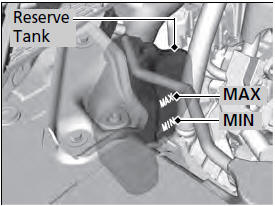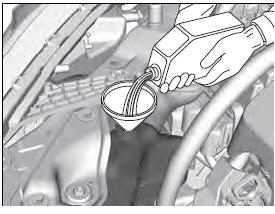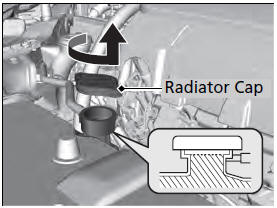 Honda Accord: Engine Coolant
Honda Accord: Engine Coolant

This coolant is premixed with 50% antifreeze and 50% water. Do not add any straight antifreeze or water.
We recommend you check the engine coolant level every time you refuel. Check the reserve tank first. If it is completely empty, also check the coolant level in the radiator. Add the engine coolant accordingly.
NOTICE
If temperatures consistently below −22°F (−30°C) are expected, the coolant mixture should be changed to a higher concentration. Consult a dealer for more information.
If Honda antifreeze/coolant is not available, you may use another major brand non-silicate coolant as a temporary replacement. Check that it is a high quality coolant recommended for aluminum engines.
Continued use of any non-Honda coolant can result in corrosion, causing the cooling system to malfunction or fail. Have the cooling system flushed and refilled with Honda antifreeze/coolant as soon as possible.
Do not add rust inhibitors or other additives to your vehicle's coolant system. They may not be compatible with the coolant or with the engine components.
• Reserve Tank

1. Check the amount of coolant in the reserve tank.

2. If the coolant level is below the MIN mark,
add the specified coolant until it reaches
the MAX mark.
3. Inspect the cooling system for leaks.
• Radiator

1. Make sure the engine and radiator
are cool.
2. Turn the radiator cap counterclockwise and
relieve any pressure in the coolant system.
Do not push the cap down when turning.
3. Push down and turn the radiator cap
counterclockwise to remove it.
4. The coolant level should be up to the base
of the filler neck. Add coolant if it is low.
5. Put the radiator cap back on, and tighten it
fully.
6. Pour coolant into the reserve tank until it
reaches the MAX mark. Put the cap back
on the reserve tank.
WARNING
Removing the radiator cap while the engine is hot can cause the coolant to spray out, seriously scalding you.
Always let the engine and radiator cool down before removing the radiator cap.
NOTICE
Pour the fluid slowly and carefully so you do not spill any. Clean up any spills immediately; they can damage components in the engine compartment.
 Changing the Engine Oil and Oil Filter
Changing the Engine Oil and Oil Filter
You must change the engine oil and oil filter regularly in order to maintain
the
engine's lubrication. The engine may be damaged if they are not changed
regularly.
Change the oil and filter in ...
 Transmission Fluid
Transmission Fluid
• Continuously Variable Transmission (CVT) Fluid
Have a dealer check the fluid level and replace if necessary.
NOTICE
Do not mix HCF-2 with other transmission fluids.
Using a transmission ...
See also:
Head Restraints
Your vehicle is equipped with head
restraints in all seating positions to
help protect you and your
passengers from the likelihood of
whiplash and other injuries.
They are most effective wh ...
Driveshaft Installation
NOTE: Before starting Installation, make sure the mating
surfaces of the joint and the splined section are clean.
1 Apply about 5 g (0.18 oz) of moly 60 paste
(P/N 08734-0001) to the contact area ...
Towing Equipment and Accessories
Towing can require a variety of
equipment, depending on the size of
your trailer, how it will be used, how
much load you are towing, and
where you tow.
Discuss your needs with your trailer
...
